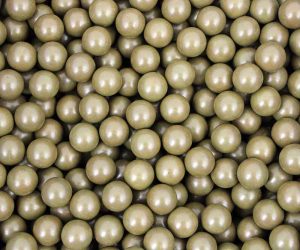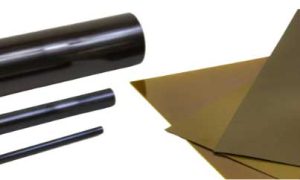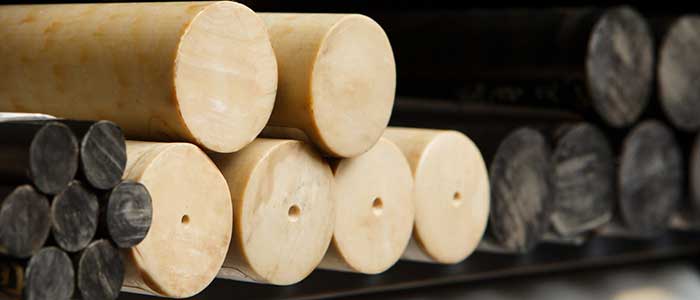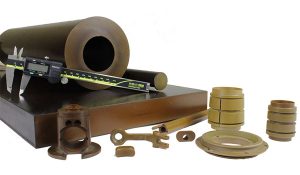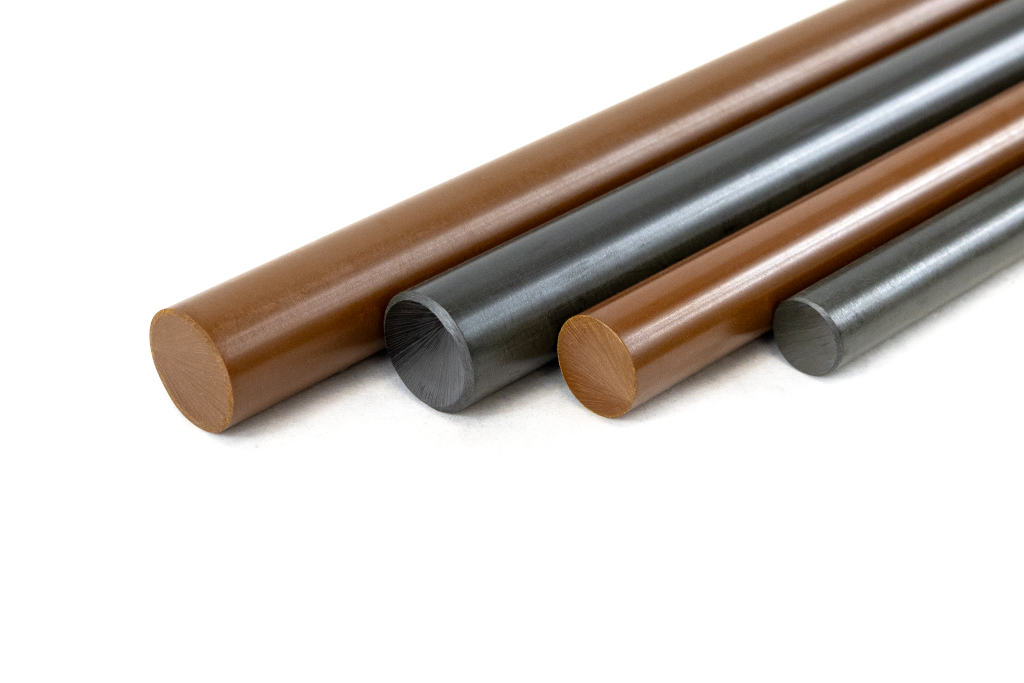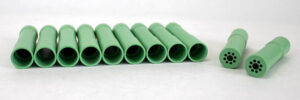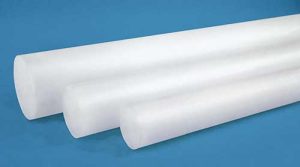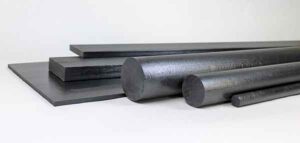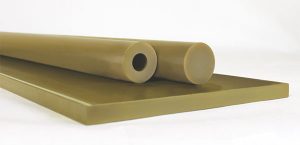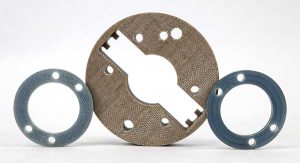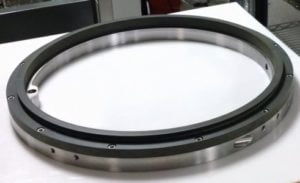Polyetherimide (PEI) Overview
Polyetherimide (PEI) is a member of the polyimide family of high-performance materials that also includes polyamide imide (PAI). An amorphous thermoplastic, PEI’s polymeric structure includes ether (E) linkages to the polyimide (PI) molecular structure. This modification allows PEI to be melt processed by injection molding and extrusion, a limitation of traditional polyimide materials such as Vespel® PI.
In its basic form, polyetherimide is transparent amber. Its performance is characterized by a high strength-to-weight ratio with strength retention up to 390°F (200°C), long term resistance to thermal oxidation, good electrical properties and inherent chemical and flame resistance. PEI is also recognized for its retention of properties after extended exposure to steam and hot water, a benefit for food processing equipment and medical applications that require aggressive cleaning or sterilization.
The proliferation of PEI grades since its introduction include several with different glass fiber reinforcement levels that increase the high-performance thermoplastic’s structural strength.
General Electric Company’s Plastics Division developed and commercialized polyetherimide in 1982 under the Ultem™PEI tradename. The plastics business with its extensive list of polymers including Ultem PEI, a material unique to GE, was later acquired by SABIC Plastics.
PEI Resin Grades, Suppliers
SABIC remains the sole producer of Ultem PEI resins and supplies the global market from plants in the US and Spain.
From the initial transparent form of the material, the Ultem PEI product line expanded quickly to address the requirements of a growing list of applications in multiple industries. A wide range of standard and custom colors were added to serve aircraft, medical and food-related applications. Different forms of Ultem PEI include moldable and extrudable pellets and coating powders to accommodate the most common production methods and applications for the material. Several of the pelletized molding and extrusion grades also contain additives to improve processability.
Among the performance-modified grades, the glass-reinforced formulations see especially widespread use for structural applications in severe environments where PEI’s inherent resistance to high temperatures, pressurized steam and many aggressive chemicals are also advantageous.
PEI Stock Shapes; Drake’s Ultem 2300 PEI Seamless Tube®
Several unfilled and modified grades of Ultem PEI are readily available in the stock shapes industry as machinable rod and plate. Drake also offers these products on request.
One of the most widely-used of the ultra high-performance fiber-reinforced PEI grades is 30% glass-reinforced Ultem 2300 PEI. It is also Drake Plastics’ primary PEI material, with products available in the form of Seamless Tube® and machined and injection molded parts. Other Ultem PEI shapes and grades are available upon request, typically with modest minimums.
A unique machinable configuration developed by Drake, Ultem 2300 Seamless Tube achieves a higher level of performance that is possible in parts machined from rod and plate. Its seamless configuration eliminates the problems associated with weld lines common in heavy-walled extruded thermoplastic tube. It also offers compelling economics for components whose configurations lend themselves to machining from tube rather than rod.
Ultem 2300 PEI Performance Characteristics
The addition of 30% milled glass fiber reinforcement provides Ultem 2300 PEI with a substantial increase in rigidity and dimensional stability at temperature extremes over the unfilled grades while maintaining the polymer’s inherent performance benefits.
Ultem 2300 PEI’s thermal properties under load earn it an appropriate position within the relatively small family of ultra high-performance materials. It has a glass transition temperature (Tg) of 419°F (215°C). The 30% glass fiber reinforcement raises its heat deflection temperature to 410°F (210°C), roughly 10% higher than the unreinforced grade. On dimensional stability over severe temperature variations, its in-flow coefficient of linear thermal expansion (CLTE) of 1.1 E-5/°F (1.98 E–5/°C) rivals aircraft grade aluminum.
Structural strength and stability
Unreinforced grades of Ultem PEI offer inherent rigidity and stability at high temperatures under load. The addition of 30% glass fiber reinforcement affords Ultem 2300 a major step up in structural behavior. Its flexural modulus of 1,300,000 psi (8,960 MPa) is over two-and-a-half times greater than that of unreinforced Ultem PEI, and results in frequent specifications for the 2300 grade for chemical handling applications that experience high physical loads approaching its glass transition temperature.
Hydrolytic stability
Like all Ultem PEI grades, Ultem 2300 PEI resists physical properties degradation when subjected to steam and exposure to water for extended periods. Its low moisture absorption (0.90% by weight at saturation) and its resultant dimensional stability make it a good candidate for pump components and electrical connectors that require temperature and chemical resistance and high strength along with retention of precise dimensions in wet conditions.
High dielectric strength
The inherent electrical properties of the Ultem PEI polymer carry over to glass-reinforced Ultem 2300 as well. Measuring 770 V/mil in oil and 630 V/ mil in air, the dielectric strength of Ultem 2300 results in frequent specifications for the high-performance thermoplastic in electrical insulation and isolation components. Typical applications include electrical connectors, device housings and bodies, coil bobbins and terminal blocks. Ultem PEI’s base resin offer the highest dielectric strength of any commercially available thermoplastic on the market (regardless of whether it be a semi-crystalline or amorphous polymer).
Environmental stress crack resistance
Ultem PEI outperforms many other amorphous thermoplastics on chemical resistance because of its polyimide-based polymeric structure. The high-performance thermoplastic withstands exposure to most automotive and aircraft fluids, aliphatic hydrocarbons, alcohols, acids, and weak aqueous solutions. Because of the variability in chemical concentrations, temperatures and physical loads, all applications of Ultem PEI and any other material must be tested under actual conditions to determine a material’s suitability for use.
Flammability and smoke generation
Ultem 2300 PEI, like most grades of PEI, exhibits Inherent flame resistance without the need for fire retardant additives. It has a limiting oxygen index (LOI) of 50% and carries UL94 V-0 and 94 V5A ratings in specific UL tested thicknesses. The 30% glass-reinforced PEI grade also generates low smoke, making it a candidate for certain structural and electrical components in aircraft.
Performance and Cost Advantages: Drake’s Ultem 2300 PEI Seamless Tube®
Drake Plastics developed its Seamless Tube® process technology to overcome the performance problems associated with weld line integrity in heavy-walled extruded tube. This unique stock shape configuration also yields several other advantages in both performance and cost in finished machined parts and components.
Higher strength
Drake’s Ultem 2300 PEI Seamless Tube exhibits far higher hoop strength compared to tubular configurations machined from rod. Independent burst tests show that Seamless Tube delivers twice the resistance to rupturing, an important factor for parts that experience high internal or external pressures and loads.
Because Seamless Tube is produced with uniform flow throughout the cross section, it eliminates weak “weld” lines and withstands far greater internal or external radial stress loads.
Improved dimensional stability
Drake’s Ultem 2300 PEI Seamless Tube has a coefficient of linear thermal expansion (CLTE) of both the OD and ID that closely parallels the resin supplier’s resin data sheet in-flow values. This consistency results from Drake Plastics’ expertise in producing Seamless Tube with uniform fiber orientation around its full circumference.
Greater tolerance control in machining
Drake’s machining customers report better tolerance control especially on roundness and concentricity with Seamless Tube vs. rod and plate stock.
When cylindrical parts are machined from rod, their OD can shrink when material is cored out to make a circular configuration. This is because during melt extrusion of thermoplastic rod, the mass of material at the rod’s core typically cools at a slow rate, yielding a different internal stress level than the outer portion which cools more quickly. The core also “binds” the outer area of the rod. When machined away, the internal stress differential of the core vs. the rod’s perimeter can cause the machined part to distort and take an oval shape.
Drake’s Ultem 2300 PEI Seamless Tube eliminates the core material and demonstrates consistent behavior throughout the cross-section when machined.
Reduced loss of material and machining time
With Ultem 2300 PEI Seamless Tube, drilling is eliminated and the ID size and tolerance can be quickly and accurately machined. This significantly reduces material loss associated with machining circular configurations by coring out rod. It also reduces drilling hours and tool wear, both of which can be significant with abrasive fiber-reinforced materials like Ultem 2300 PEI.
OD/ID combinations with fast turn-around
Ultem 2300 PEI Seamless Tube serves many maintenance and repair operations in oil and gas and other industries where fast turn-around is critical to maintain operations. Drake produces a vast array of Ultem 2300 PEI Seamless Tube OD/ID combinations for rapid turn-around. The size range also allows material and machining efficiency, benefits that align precisely with Drake’s lean manufacturing philosophy.
Typical Ultem 2300 PEI Seamless Tube® Applications
- Structural components, rings, seals in oil and gas and chemical processing equipment.
- Thermal insulators; electrical insulators and isolators.
- Structural aircraft components, electrical connectors, component and lighting housings.
- Electrical connector blocks, bodies and coil bobbins.
PEI Medical Grades
Medical grades of the PEI polymer are available that have been pre-assessed for biocompatibility according to ISO 10993. They provide medical device manufacturers with different options on processability, performance and biocompatibility for applications that are injection molded or precision machined. All grades are offered in natural and healthcare colors.
Ultem HU 1000
Ultem HU 1000 is a medical grade of PEI developed for devices and device components that are in contact with bodily fluids and tissue for up to 24 hours. Typical applications are repeated-use surgical instruments and instrument handles that undergo multiple sterilization cycles.
Ultem HU-1000 is available as machinable stock shapes, and in pelletized form for injection molding or melt extrusion.
Ultem HU-1010
Ultem HU-1010 is a lower melt viscosity version of Ultem HU 1000. Its higher melt flow is preferable for injection molding intricate precision parts or those with very thin wall sections. The HU 1000 and HU 1010 grades have comparable properties and meet biocompatibility standards for devices that are in contact with bodily tissue and fluids for 24 hours or less.
Ultem HU 1004 PEI
Ultem HU 1004 PEI complies with ISO 10993 biocompatibility protocol for applications that are in contact with internal bodily tissue and fluids for up to 29 days. It is produced from a proprietary blend of PEI and another polymer that imparts more impact resistance than the Ultem HU 1000 PEI grade. It also retains a high degree of the PEI polymer’s mechanical properties. Candidate applications include dialysis components and post-operative drainage devices that remain in the body for extended periods of up to 4 weeks.
Ultem HU 1040 stock shapes are available for precision machining. The pelletized form of the resin is also available for melt processing by extrusion or injection molding.
Ultem HU 2300
Ultem HU 2300 is a 30% glass-reinforced medical grade of PEI that complies with ISO 10993 and USP Class VI standards. Its glass fiber content provides exceptionally high structural strength for devices that involve short-term (up to 24 hours) contact with internal bodily tissue and fluids. It should be noted that machining stock shapes made from these types of reinforced plastics can expose internal glass fibers. Consequently, medical device parts in Ultem HU 2300 are typically made by injection molding, where the correct process conditions can impart a resin-rich surface.
Sterilization Resistance
PEI medical grades are compatible with sterilization methods commonly used in healthcare facilities, exhibiting minimal property degradation and color drift after numerous cycles. The Ultem HU 1004 grade is particularly notable for its retention of ductility and its minimal color drift after an extreme 300 cycles in STERRAD NX, 100NX and AMSCO V-PRO systems.
